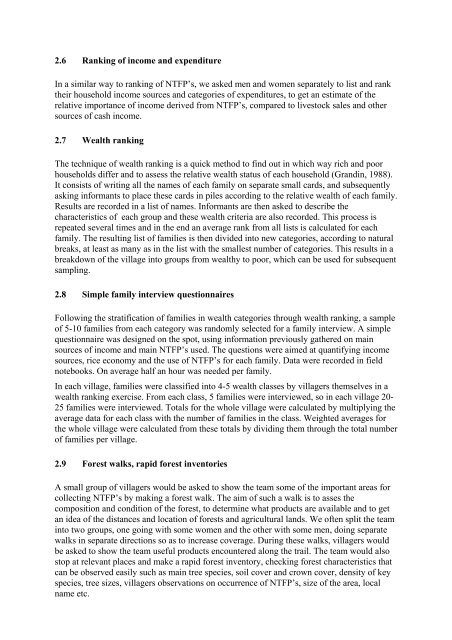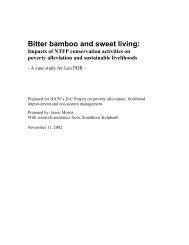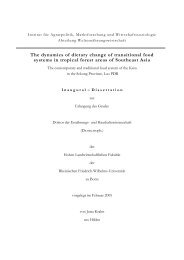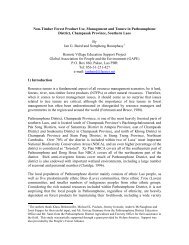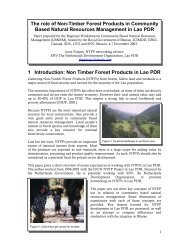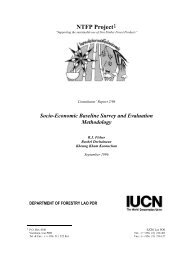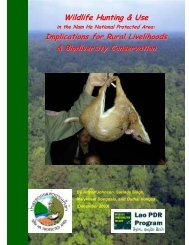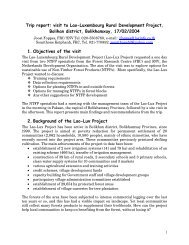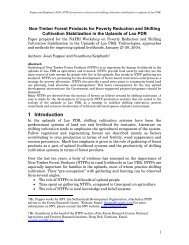You also want an ePaper? Increase the reach of your titles
YUMPU automatically turns print PDFs into web optimized ePapers that Google loves.
2.6 Ranking of income and expenditure<br />
In a similar way to ranking of NTFP’s, we asked men and women separately to list and rank<br />
their household income sources and categories of expenditures, to get an estimate of the<br />
relative importance of income derived from NTFP’s, compared to livestock sales and other<br />
sources of cash income.<br />
2.7 Wealth ranking<br />
The technique of wealth ranking is a quick method to find out in which way rich and poor<br />
households differ and to assess the relative wealth status of each household (Grandin, 1988).<br />
It c<strong>on</strong>sists of writing all the names of each family <strong>on</strong> separate small cards, and subsequently<br />
asking informants to place these cards in piles according to the relative wealth of each family.<br />
Results are recorded in a list of names. Informants are then asked to describe the<br />
characteristics of each group and these wealth criteria are also recorded. This process is<br />
repeated several times and in the end an average rank from all lists is calculated for each<br />
family. The resulting list of families is then divided into new categories, according to natural<br />
breaks, at least as many as in the list with the smallest number of categories. This results in a<br />
breakdown of the village into groups from wealthy to poor, which can be used for subsequent<br />
sampling.<br />
2.8 Simple family interview questi<strong>on</strong>naires<br />
Following the stratificati<strong>on</strong> of families in wealth categories through wealth ranking, a sample<br />
of 5-10 families from each category was randomly selected for a family interview. A simple<br />
questi<strong>on</strong>naire was designed <strong>on</strong> the spot, using informati<strong>on</strong> previously gathered <strong>on</strong> main<br />
sources of income and main NTFP’s used. The questi<strong>on</strong>s were aimed at quantifying income<br />
sources, rice ec<strong>on</strong>omy and the use of NTFP’s for each family. Data were recorded in field<br />
notebooks. On average half an hour was needed per family.<br />
In each village, families were classified into 4-5 wealth classes by villagers themselves in a<br />
wealth ranking exercise. From each class, 5 families were interviewed, so in each village 20-<br />
25 families were interviewed. Totals for the whole village were calculated by multiplying the<br />
average data for each class with the number of families in the class. Weighted averages for<br />
the whole village were calculated from these totals by dividing them through the total number<br />
of families per village.<br />
2.9 Forest walks, rapid forest inventories<br />
A small group of villagers would be asked to show the team some of the important areas for<br />
collecting NTFP’s by making a forest walk. The aim of such a walk is to asses the<br />
compositi<strong>on</strong> and c<strong>on</strong>diti<strong>on</strong> of the forest, to determine what products are available and to get<br />
an idea of the distances and locati<strong>on</strong> of forests and agricultural lands. We often split the team<br />
into two groups, <strong>on</strong>e going with some women and the other with some men, doing separate<br />
walks in separate directi<strong>on</strong>s so as to increase coverage. During these walks, villagers would<br />
be asked to show the team useful products encountered al<strong>on</strong>g the trail. The team would also<br />
stop at relevant places and make a rapid forest inventory, checking forest characteristics that<br />
can be observed easily such as main tree species, soil cover and crown cover, density of key<br />
species, tree sizes, villagers observati<strong>on</strong>s <strong>on</strong> occurrence of NTFP’s, size of the area, local<br />
name etc.


